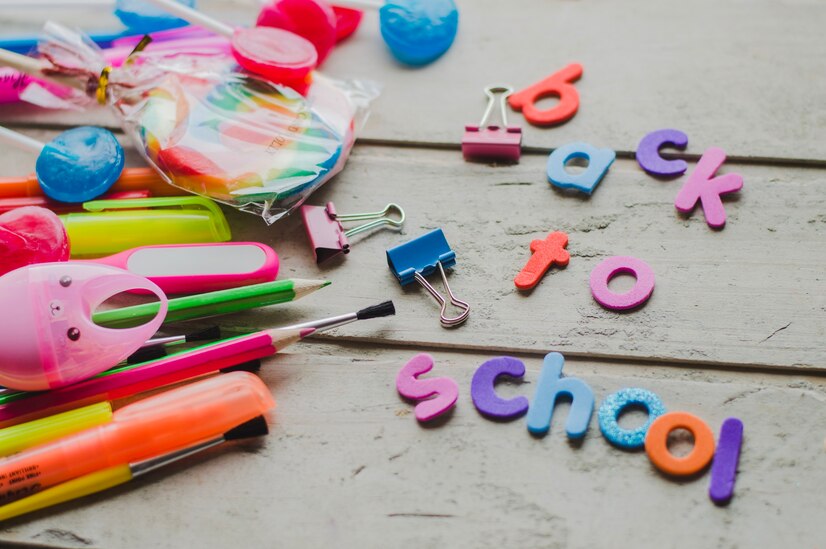Whether you’re a first year teacher or a veteran teacher with decades of experience, back to school season is always a busy time.
From breaking the ice and getting to know students to establishing norms and setting boundaries, there is SO much to get done.
That’s why I’m sharing my list of the top 5 activities to do with your students during the first week of school!
1. Break the Ice
Students learn best from people they trust and when they feel safe and welcome in their physical and social environment, so instead of jumping in with establishing routines and procedures or diving into curriculum, spend the first few days getting to know your students and building relationships.
There are TONS of ways to break the ice, but here are 3 of my all-time favorites:
Icebreaker #1: The (Dreaded) Name Game
This one gets a bad wrap because there are a LOT of corny variations.
I keep my version simple: on their turn, each student shares their name, 3 facts about him or herself, and then names all the students who have gone before. And that’s it.
It sounds simple (and it is!), but students are always SO engaged in the game and you’ll be able to get a great sense of each student’s personality, not just from the facts they share, but also from the way they approach the game.
The name game is awesome for us secondary teachers because – let’s face it – we have a LOT of names to learn and we need to learn them FAST!
You can read more about the name game for secondary students here!
Icebreaker #2: Speed Dating
Students have 2 or 3 minutes to ask each other questions before changing partners. Their only goal is to talk the whole time – they can choose whether they cover several questions or just one question, based on whatever feels natural.
Be sure to provide students with a menu of questions to choose from, so that students aren’t scrambling to think of questions to ask!
Icebreaker #3: Gather Round
Students create small groups based on things they have in common. For example, you might ask students to find peers with the same favorite sport and students will move into groups based on their favorite.
I always like to encourage students to chat a little in their groups with follow up questions. For example, for the question above, I might ask them to discuss what they like most about the sport.
Read the first-day of school icebreakers post if you’re interested in learning more about about these using these icebreakers!
2. Establish Rules and Procedures

I always spend the first day playing an icebreaker game, but it’s also key to establish your rules and procedures early in the year.
While it may not be the most exciting content ever, I notice students seem to really settle in after I cover rules, procedures, and expectations.
I think of it like giving a tour. Imagine you go to a friend’s house for the first time. What does your friend do? She walks you through the house, showing you where to leave your shoes, a table you can set your purse and keys on, where the bathroom is, and how to get a drink if you’re thirsty.
If you’ve ever been to a friend’s house and not gotten a tour, you always feel a little awkward – wandering the halls looking for a bathroom or opening random cabinets and drawers to find a cup or a spoon.
This is exactly how students feel in our classrooms too!
They want to know how to use the bathroom appropriately in your class, how and where and when to turn in papers, where to get materials they need, etc.
A few years ago, I started adding little verbal “quizzes” – checks for understanding really – to engage students in the rules and procedures presentation and to help break things up.
For example, after reviewing and explaining how I use both a website and an “absent box” for keeping track of missing work, I ask students to tell their seat partner what to do if they’re absent.
3. Do a Syllabus Scavenger Hunt

Your syllabus is probably the most important single material you’ll hand your students all year.
It might seem boring, but it’s an amazing resource for students because it condenses all the information they need to be successful into a single place they can refer back to all year.
Need to contact your teacher? It’s on the syllabus.
Need to tell your parents what room to go to for a meeting with your teacher? It’s on the syllabus.
Need to know the policy for turning in a late assignment or what will happen to your friend you noticed plagiarized? It’s on the syllabus.
The syllabus also sets students up for success because it gives students a clear understanding of what they’re learning, what your goals are for the semester, and what skills and concepts students need to demonstrate mastery in in order to be successful.
BUT, none of that changes the fact that going over the syllabus is still pretty dry.
Instead of boring your students to death while you read the syllabus out loud, try introducing the syllabus with a scavenger hunt activity.
How? Create a “scavenger hunt” activity that asks students to find specific information from the syllabus that will probably be most relevant to them.
Not only does the scavenger hunt strategy work to engage students in the syllabus, it also helps to show students the kind of behavior norms you want to see in class.
For example, students practice active reading as they work and they can collaborate and discuss with peers and small groups while they work. The scavenger hunt activity is great for this because finding the information and answering the questions tends to be straightforward, allowing students to focus on collaboration and active reading before moving to more difficult reading assignments.
4. Collect a Writing Sample
I want to get to know my students as quickly as possible, and while icebreakers help tremendously with names, personality, and speaking ability, I also make sure to collect a writing sample as soon as possible as well.
Instead of asking students to write something difficult, I prefer to ask students to write something fun and informal, especially because I really want students to think of writing as something that can be fun!
For the last few years, I’ve used a postcard creative writing activity for the writing sample.
For this activity, I set out a pile of postcards in the back and let students sift through and choose a card from the pile.
Then I ask students to imagine they’re the person buying the postcard – why would they buy it and who would they buy it for? Why are they sending it and what do they have to say?
Students spend 20-30 minutes writing a letter based on the postcard they chose and their answers to those questions.
When time is up, I collect the postcards and the letter and then pass them out randomly to different students.
The student who received the letter and postcard, imagines they’re the person receiving the postcard and writes a response “in character”.
The only rule is they’re not allowed to ask the original writer any questions about the characters or situation – anything not clear in the letter is fair game for them to make up.
At the end of the activity, students find their postcard partner, share the response letter, and have a chance to debrief.
Then students turn in their letters to me.
The trick to this one is collecting postcards – depending on where you live, you can usually find them at general stores, train stations and airports, tourist shops, and museums and attractions. If none of those works, ask friends to send you some blank ones when they vacation or simply buy some online!
5. Set up Technology Accounts
Technology can save a ton of time throughout the year, but getting started and setting things up can take a LOT of time.
Instead of having to stop each time we use a new website or app, I make a list of all the sites and apps I plan to use and dedicate a day to creating accounts and recording usernames and passwords.
I usually ask students to use a formula for their password to make it easy for them to remember later and I usually ask them to record their username and password for each site on a page in their notebook.
For extra insurance, I ask students to email me all those usernames and passwords, and I paste all the login information for the whole class into a single document. This way, if students have trouble logging in, I can quickly and easily help them get back on track.

